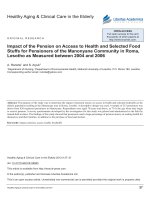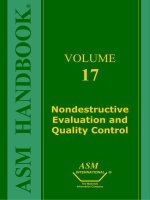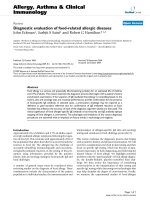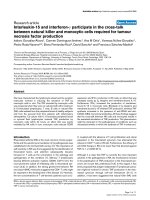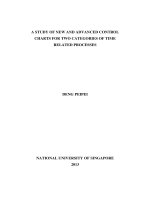Field evaluation of the strategies of integration of fungicides and bio control agents for efficient management of rice stem rot disease
Bạn đang xem bản rút gọn của tài liệu. Xem và tải ngay bản đầy đủ của tài liệu tại đây (157.35 KB, 5 trang )
Int.J.Curr.Microbiol.App.Sci (2018) 7(7): 3796-3800
International Journal of Current Microbiology and Applied Sciences
ISSN: 2319-7706 Volume 7 Number 07 (2018)
Journal homepage:
Original Research Article
/>
Field Evaluation of the Strategies of Integration of Fungicides and Bio
Control Agents for Efficient Management of Rice Stem Rot Disease
Atla Ranga Rani1*, C.P.D. Rajan2, R. Sarada Jayalakshmi Devi1,
V. Lakshmi Narayana Reddy3 and P. Sudhakar4
1
Department of Plant Pathology, 3Department of Genetics and Plant Breeding, 4Department
of Crop Physiology, S.V. Agricultural College, Tirupati, 517502, India
2
Agricultural Research Station, Nellore, ANGRAU, Andhra Pradesh, India
*Corresponding author
ABSTRACT
Keywords
Integration
strategies,
Fungicides,
Antagonist,
S. oryzae, Rice,
Stem rot
Article Info
Accepted:
26 June 2018
Available Online:
10 July 2018
Stem rot of rice, caused by Sclerotia oryzae is a serious threat to rice production in India.
Fungicides only provide limited control of this pathogen but also have ill effects on the
environment. In an attempt to develop better integrated strategies for management of this
disease, a field study was conducted during rabi 2017-18 to evaluate the strategies of
integration of effective fungicide Hexaconazole (0.2 %) and the bacterial antagonistic
isolate P.F-4 which were effective against S. oryzae in vitro studies. Among the seven
stratagies, the following integration strategies were statistically superior in managing the
stem rot disease, Alternate sprays with Hexaconazole and P.F-4 (40.00 PDI, 7.56t/ha grain
yield and 10.26t/ha straw yield) which was statistically at par with Seedling dip with P.F-4
and two sprays followed by two sprays with Hexaconazole (44.40 PDI, 6.95t/ha grain
yield and 8.53t /ha straw yield) and Two sprays with Hexaconazole followed by two
sprays with P.F-4 (48.35 PDI, 7.37t/ha grain yield and 7.73t/ha straw yield).While in
Untreated control significantly higher stem rot disease was recorded with 67.83 PDI when
compared with all other treatments.
Introduction
Rice (Oryzae sativa L.) is one of the important
staple food crops for more than 60 per cent of
the world’s population. Globally rice occupied
an area of about 159.80 million hectares with
740.96 million tonnes of production and
productivity of 4.63 metric tonnes per hectare
(Directorate of Economics and Statistics,
2016). Various biotic and abiotic stress cause
immense loss to rice crop wherever the crop is
grown. Due to apparent changes in climatic
conditions and change of genotypes and
cultivation practices the profile of diseases on
rice has changed over a period of time. Stem
rot of rice caused by Sclerotium oryzae
Catt.(Magnaporthe salvinii (Catt.) is one of
the major constraints for rice production in the
Indian subcontinent especially in Haryana
(Singh et al., 2002). The pathogen has been
reported to cause substantial losses in grain
yield ranging from 5-80 per cent (Kumar et
al., 2003). It was considered desirable to
evaluate the efficacy of some chemical
3796
Int.J.Curr.Microbiol.App.Sci (2018) 7(7): 3796-3800
fungicides against the disease. Efficacy of
bacterial biocontrol antagonists has been
reported by Elangovan and Gnanamanickam
(1992); and Sakthivel et al., (1988). But
biocontrol agents alone cannot manage the
disease completely when infection is already
established in huge amounts in the field.
Therefore, farmers favoured fungicides for
managing the disease. Fungicides are
deleterious to the environment and also
harmful for the soil productivity and human
and animal health. Due to the disadvantages of
fungicides, integrated disease management
programs are applied, in which judicious and
recommended use of fungicides and their
integration with biocontrol agents is favoured.
Hence, the present investigation was carried to
evaluate the strategies of integration of
effective fungicide and the bio control agent
for efficient management of rice stem rot
disease.
Materials and Methods
A field experiment was conducted in
randomized complete block design (RBD) at
the experimental fields of Agricultural
Research Station, Nellore, Andhrapradesh
during rabi 2017-18. A popular rice variety
MTU 1010 which was susceptible to stem rot
diseases was transplanted with a spacing of 15
x 15 cm in a gross plot size of 13.455 sq m. A
check plot was also maintained. The root
dipping of the nursery was done in the
suspension of the respective bacterial isolate
before transplanting. The bacterial isolate P.F4 was sprayed at concentration of 106 CFU /ml
of suspension. Hexaconazole was sprayed at
the 0.2 % concentration.
Disease assessment and statistical analysis
Fifteen days after the each spray of fungicide
and bio agent disease assessment was carried
out. Disease severity was measured based on
0-9 scale (SES, IRRI, 2013). Further, the
scored data was converted into per cent
disease index (PDI) using formula given
below. The data on disease severity and yield
parameters were subjected to appropriate
statistical analysis.
PDI = [(Sum of the scores) / (Number of
Observation X Highest Number in Rating
Scale)] x 100
Results and Discussion
Stem rot disease of rice is a soil borne disease
and causes crop damage from tillering stage to
till harvest of the crop. Several reports are
available on chemical and biological method
of disease management under field condition
(Phurailatpam et al., 2014; Gopika et al.,
2016). Results of the study presented in table
1 and 2 revealed that, at 15 days after the first
spraying, T4 (Seedling dip with P.F-4 and two
sprays followed by two sprays with
Hexaconazole) showed lowest per cent disease
index (PDI) of 16.00 which was closely
followed by T5 (Alternate sprays with
Hexaconazole and P.F-4; 17.00 PDI), T1
(Hexaconazole; 18.00 PDI) and T6 (Alternate
sprays with P.F-4 and Hexaconazole; 20.00
PDI). These treatments were significantly at
par with each other with regard to PDI. The
untreated control (T8) with 30.00 PDI which
was statistically at par with the treatments T2
(Seedling dip with Pseudomonas fluorescens
(P.F-4) and foliar spray; 27.00 PDI) and T7
(Seedling dip with P.F-4 followed by mixed
spray of Hexaconazole and P.F-4; 25.00 PDI).
The treatment T3 (Two sprays with
hexaconazole followed by two sprays with
P.F-4) with 22.00 PDI was found to be at par
with all the treatments except untreated
control (T8) and T4 (Seedling dip with P.F-4
and two sprays followed by two sprays with
hexaconazole) treatments.
At 15 days after the second spraying, lowest
per cent disease index (PDI) was observed in
3797
Int.J.Curr.Microbiol.App.Sci (2018) 7(7): 3796-3800
T5 (Alternate sprays with Hexaconazole and
P.F-4; 21.47 PDI) which was at par with the
treatments T1 (Hexaconazole; 22.78 PDI), T6
(Alternate
sprays
with
P.F-4
and
Hexaconazole; 24.00 PDI).The untreated
control (T8) with 40.00 PDI which showed
significantly higher stem rot disease when
compared to all other treatments. Stem rot PDI
in treatments T3, T4, T7 and T2 ranged from
28.53 to 34.00 were found to be at par among
themselves. This indicated that all these
treatments have almost equal efficacy against
stem rot disease. At 15 days after the third
spraying, lowest per cent disease index (PDI)
of 30.00 was observed in T5 (Alternate sprays
with Hexaconazole and P.F-4) which was at
par with the treatments T1 (Hexaconazole;
32.00 PDI), T6 (Alternate sprays with P.F-4
and Hexaconazole; 33.45 PDI), T4 (Seedling
dip with P.F-4 and two sprays followed by
two sprays with Hexaconazole; 35.49) and T3
(Two sprays with Hexaconazole followed by
two sprays with P.F-4; 36.00 PDI).
Table.1 Field Evaluation of the strategies of integration of fungicide and biocontrol agent for
efficient management of rice stem rot disease during Rabi 2017-18
S.No
Treatments
T1
Hexaconazole
T2
Seedling dip with Pseudomonas
fluorescens (P.F-4)and foliar
spray
Two sprays with Hexaconazole
followed by two sprays with
P.F-4
Seedling dip with P.F-4 and two
sprays followed by two sprays
with Hexaconazole
Alternate
sprays
with
Hexaconazole and P.F-4
Alternate sprays with P.F-4 and
Hexaconazole
Seedling dip with P.F-4
followed by mixed spray of
Hexaconazole and P.F-4
Control
T3
T4
T5
T6
T7
T8
CD(0.05)
CV
Figures in parenthesis are arc sine values
Each treatment replicated thrice
Percent disease index (PDI)
15 Days
15 Days
15 Days
st
nd
after 1
after 2
after 3rd
spray
spray
spray
18.00
22.78
32.00
(25.08)de
(28.49)d
(34.42)d
27.00
34.00
44.36
ab
b
(31.26)
(35.66)
(41.75)ab
15 Days
after 4th
spray
49.93
(44.96)bc
56.00
(48.46)b
22.00
(27.95)bcd
28.53
(32.27)c
36.00
(36.85)cd
48.35
(44.05)bcd
16.00
(23.55)e
30.66
(33.60)bc
35.49
(36.55)cd
44.40
(41.76)cd
17.00
(24.32)de
20.00
(26.49)cde
25.00
(29.95)abc
21.47
(27.52)d
24.00
(29.28)d
32.00
(34.42)bc
30.00
(33.17)d
33.45
(35.30)cd
40.00
(39.21)bc
40.00
(39.21)d
52.22
(46.28)bc
54.00
(47.29)bc
30.00
(33.17)a
3.965
8.166
40.00
(39.21)a
2.736
4.797
50.31
(45.18)a
4.357
6.579
67.83
(55.53)a
5.534
6.877
3798
Int.J.Curr.Microbiol.App.Sci (2018) 7(7): 3796-3800
Table.2 Effect of the strategies of integration of fungicide and biocontrol agent on yield of rice
S.No
T1
T2
T3
T4
T5
T6
T7
T8
Treatments
Hexaconazole
Seedling dip with Pseudomonas fluorescens (P.F-4)and foliar spray
Two sprays with Hexaconazole followed by two sprays with P.F-4
Seedling dip with P.F-4 and two sprays followed by two sprays
with Hexaconazole
Alternate sprays with Hexaconazole and P.F-4
Alternate sprays with P.F-4 and Hexaconazole
Seedling dip with P.F-4 followed by mixed spray of Hexaconazole
and P.F-4
Control
CD(0.05)
CV
The untreated control (T8) showed 50.31 PDI
which was statistically at par with the treatment
T2 (Seedling dip with Pseudomonas fluorescens
(P.F-4) and foliar spray; 44.36 PDI). However,
treatment T7 (Seedling dip with P.F-4 followed
by mixed spray of Hexaconazole and P.F-4;
40.00 PDI) was statistically at par with T2
(Seedling dip with Pseudomonas fluorescens
(P.F-4) and foliar spray; 44.36 PDI).
At 15 days after the fourth spraying, lowest per
cent disease index (PDI) was observed in T5
(Alternate sprays with Hexaconazole and P.F-4;
40.00 PDI) which was statistically at par with
T4 (Seedling dip with P.F-4 and two sprays
followed by two sprays with Hexaconazole;
44.40 PDI) and T3 (Two sprays with
Hexaconazole followed by two sprays with P.F4; 48.35 PDI).While in T8 (Untreated control)
significantly higher stem rot disease was
recorded with 67.83 PDI when compared with
all other treatments. The stem rot PDI in T1, T6,
T7, T2 treatments ranged from 49.93 to 56.00
which were at par with each other indicating
their statistically equal efficacy in reducing the
disease. The results in present investigation
revealed that, the following integration
strategies were statistically superior in
managing the stem rot disease and also
Rabi 2017-18
Grain yield
Straw yield
(t/ha)
(t/ha)
bc
6.70
7.99b
6.41 c
7.76 bc
7.37 ab
7.73 bc
abc
6.95
8.53b
7.56 a
6.92 abc
6.87 bc
10.26 a
7.60 bc
6.92 c
5.44d
0.769
6.457
5.76d
1.041
7.597
obtaining in good yields. Alternate sprays with
Hexaconazole and P.F-4 (T5 with 40.00 PDI;
7.56t/ha grain yield and 10.26t/ha straw yield).
Seedling dip with P.F-4 and two sprays
followed by two sprays with Hexaconazole (T4
with 44.40 PDI, 6.95t/ha grain yield and 8.53t
/ha straw yield). Two sprays with Hexaconazole
followed by two sprays with P.F-4(T3 with
48.35PDI, 7.37t/ha grain yield and 7.73t/ha
straw yield). In integrated management, the
fungicide might have weakened the sclerotia
making them more sensitive to antagonists. The
present hypothesis is in agreement with the
findings of Henis and Papavizas (1983) who
also reported that sclerotia of S. rolfsii were
weakened at sub–lethal concentrations of
metham sodium and become sensitive to
invasion and degradation by T. harzianum.
However, the fungicide alone does not degrade
fresh sclerotia. In such situation, the weakened
or dead cells of pathogen might have served as
enrichment medium for the multiplication of
antagonists. Soil application of biocontrol
agents have an edge over seed treatment, as
these being natural soil inhabitants, they
establish and multiply more quickly in soil
(Vyas and Mathur, 2002). The present findings
were supported by other workers accordingly
the integration of biocontrol agent with
3799
Int.J.Curr.Microbiol.App.Sci (2018) 7(7): 3796-3800
compatible fungicide gave significantly higher
disease control in several crops than obtained
by either biocontrol agent (or) fungicide (Singh
and Sinha 2007 and Daroga et al., 2007).
Gopika and Jagadeeshwar (2017) conducted
integrated management studies against stem rot
of rice with twelve treatments. Of the twelve
treatments combined soil application of
butachlor (400 ppm) 8-10 days after inoculation
by the pathogen followed by application of T.
viride @ 10 g kg-1 and P. fluorescens@10 ml
kg-1 just at the appearance of the disease
recorede the disease index (0.6), followed by
spraying of propiconazole (100 ppm) with 1.2
(disease index) were found superior over other
treatments in reducing the disease.
Hence, it is concluded in the present
investigation, we are reporting that reduced
disease severity due to integration strategies
was reflected in the final yield of the crop. For
successful management of rice stem rot disease
under field condition integration of chemical
and biological methods were essential as there
were no resistant cultivars are available.
References
Savithiry, S., Gnanamanickam, S. S and
Mahadevar, A. 1988. Beneficial bacteria for
plant disease management. Advances in
research on plant pathogenic bacteria based
on the proceedings of the National
Symposium on Phytobacteriology held at
the University of Madras, Madras, India
during March 14-15, 1986. 213-220.
Singh, R., Kumar, A. and Jalali, B. L., 2002.
Variability, predisposing factors and
management of stem rot caused by
Sclerotium oryzae, An Overview. Annual
Review of Plant Pathology. 1: 275-289.
Singh, R and Sinha, A.P. 2007. Management of
sheath blight of rice with Pseudomonas
fluorescens. Journal of Mycology and Plant
Pathology. 37 (1): 18-21.
Standard evaluation system for rice (SES). 2013.
International Rice Research Institute. 5th
edition. Phillipines.
Daroga, Singh., Singh, V.K., Gopal, Singh and
Singh, U. S. 2007. Integrated management
of sheath blight and sheath rot by using
Trichoderma viride and validamycin in rice
cv.
Pusa
Basmati-1.
Progressive
Agriculture. 7 (1/2): 181-182.
Gopika, K and Jagadeeshwar, R. 2017. Studies on
disease incidence and efficacy of
fungicides, herbicides and antagonists
micro flora against stem rot of rice
(Sclerotium oryzae) along with integrated
management. Agriculture Update. 12(7):
2077-2087.
Henis, Y and Papavizas, G.C. 1983. Factors
affecting germinability and susceptibility to
attack of sclerotia of Sclerotium rolfsii by
Trichoderma harzianum in field soil.
Phytopathology. 3: 1469-1474.
Vyas, R.K and Mathur, K. 2002. Distribution of
Trichoderma spp. in cumin rhizosphere and
their potential in suppression of wilt. Indian
Phytopathology. 55: 451-457.
Directorate of Economics and Statistics. 2016.
Area and production of Rice in India. 201516.
Elangovan, C and Gnanamanikum, S.S. 1992.
Incidence of Pseudomonas fluorescens in
rhizosphere of rice and their antagonism
towards
Sclerotium
oryzae.
Indian
Phytopathology. 45 (3): 358-361.
Kumar, A., Ram Singh and Jalali, B.L. 2003.
Management of stem rot of rice with
resistance
inducing
chemicals
and
fungicides. Indian Phytopathology. 56 (3):
266-269.
Sakthivel, N., Sivamani., Anuratha, C. S.,
How to cite this article:
Atla Ranga Rani, C.P.D. Rajan, R. Sarada Jayalakshmi Devi, V. Lakshmi Narayana Reddy and P.
Sudhakar. 2018. Field Evaluation of the Strategies of Integration of Fungicides and Bio Control Agents
for Efficient Management of Rice Stem Rot Disease. Int.J.Curr.Microbiol.App.Sci. 7(07): 3796-3800.
doi: />
3800

